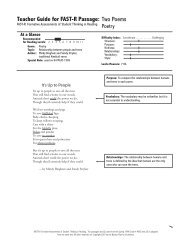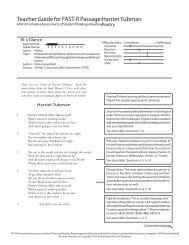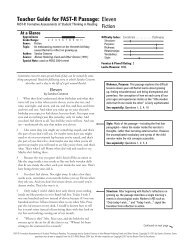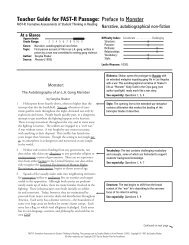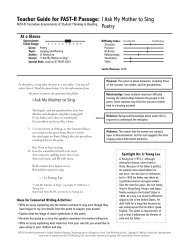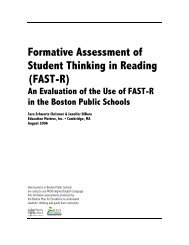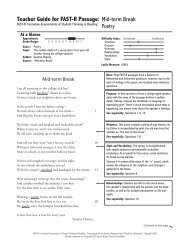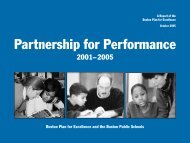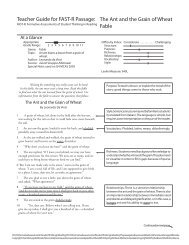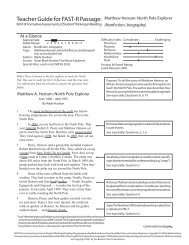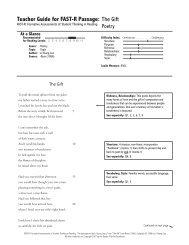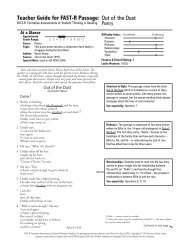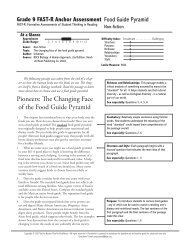Inside Alaska - Boston Plan for Excellence
Inside Alaska - Boston Plan for Excellence
Inside Alaska - Boston Plan for Excellence
You also want an ePaper? Increase the reach of your titles
YUMPU automatically turns print PDFs into web optimized ePapers that Google loves.
Teacher Guide <strong>for</strong> FAST-R Passage:<br />
FAST-R: Formative Assessments of Student Thinking in Reading<br />
At a Glance<br />
Approximate<br />
Grade Range: 2 3 4 5 6 7 8 9 10 11<br />
Genre: Non-fiction<br />
Topic: Exploration of caves in <strong>Alaska</strong> has led scientists to<br />
a new theory of how people migrated to the Americas<br />
thousands of years ago<br />
Author: Rob Knotts<br />
Source: Highlights <strong>for</strong> Children magazine<br />
Special Note: used on G7 MCAS 2003<br />
<strong>Inside</strong> <strong>Alaska</strong><br />
In<strong>for</strong>mational Non-fiction<br />
Difficulty Index: Considerate . . . . . . . . . . . . Challenging<br />
Structure:<br />
Purpose:<br />
Richness:<br />
Relationships:<br />
Vocabulary:<br />
Style:<br />
Lexile Measure: 1130L<br />
The exploration of caves in the <strong>Alaska</strong>n Rain Forests has<br />
led to interesting and unusual discoveries. Read the article<br />
below. Use the in<strong>for</strong>mation from the article to answer the<br />
questions that follow.<br />
<strong>Inside</strong> <strong>Alaska</strong><br />
by Rob Knotts<br />
1 As I lower myself into the cave, muddy rope squishes through my<br />
descending rack and spills gummy little mounds of slime down<br />
the front of my nylon suit. Three meters farther down-rope, the<br />
slanting wall veers into a narrow crack. A torrent of water blasts<br />
my face with icy spray and powerwashes my suit sparkling clean.<br />
2 “OK!” my friend Eron Gissberg shouts up from the cave passage<br />
below. “You’re at the next station.”<br />
3 I look over at a red-and-white, polka-dotted plastic ribbon that<br />
Eron has tied to a tiny knob of rock on the cave wall. The heavy<br />
stream of water still splashes off my helmet, and the flame of<br />
the carbide lantern on the helmet sputters and hisses beneath the<br />
deluge. A trickle of water finds its way down the neck of my suit.<br />
I shiver as I hold the end of a tape measure up to the ribbon, while<br />
dangling on-rope, to measure the distance from the ribbon down<br />
to the next station Eron has picked.<br />
4 “On station!” I have to yell above the noise of the waterfall <strong>for</strong><br />
Eron to hear me. The walls squeeze around me like a limestone<br />
coffin. Every breath produces a cloud of fog that makes it difficult<br />
to see.<br />
5 Eron and I are creating a map of this vertical cave on Heceta<br />
Island, <strong>Alaska</strong>. This cave and more than six hundred others like<br />
it in the Tongass National Forest in southeast <strong>Alaska</strong> are part of a<br />
program to map all the caves in the region.<br />
6 These mapping expeditions were started in 1987 by Kevin and<br />
Carlene Allred. Specially trained cavers such as Eron and I travel<br />
in float planes, helicopters, and boats to the scattered islands of<br />
southeast <strong>Alaska</strong>. These explorers spend a month each summer<br />
mapping the caves.<br />
Rain Forest in <strong>Alaska</strong><br />
7 In this rain <strong>for</strong>est, the islands get more than one hundred inches<br />
of rain yearly. Over thousands of years, rainwater has carried acid<br />
from the soil down into the cracks and crevices of the limestone<br />
bedrock, dissolving the rock and widening the fractures into the<br />
caves we know today.<br />
Purpose: The purpose of this passage, although not<br />
immediately obvious, is to show how new discoveries<br />
change our ideas about science. The narrative title and<br />
lead paragraphs <strong>for</strong> this nonfiction passage may confuse<br />
students’ idea of the purpose.<br />
See especially: Questions 1, 4, 6, 8<br />
Ideas <strong>for</strong> Connected Writing Activities<br />
• Explain the new theory scientists have developed to<br />
explain how people originally migrated to America. Give two<br />
important pieces of evidence from the article and explain<br />
how each supports the new theory.<br />
• Based on the in<strong>for</strong>mation in the passage, write a<br />
newspaper article that might have appeared in the <strong>Alaska</strong><br />
papers immediately following Dr. Heaton’s discovery in<br />
1996.<br />
Humanities Connection:<br />
• Research some of the most famous caves in the U.S.<br />
When were they discovered Mapped What have scientists<br />
learned from these caves Are there any caves in the<br />
<strong>Boston</strong>/New England area<br />
• Investigate existing theories about the origins of people in<br />
North America. Which is the most believable to you Why<br />
• Research how Canada’s “First Peoples” and the American<br />
Indians of the U.S. explain human migration...compare/<br />
contrast to other theories.<br />
Structure: 1-6 of the passage are written in a narrative<br />
style, while the remaining text follows a fact-heavy nonfiction<br />
structure.<br />
See especially: Questions 1, 4<br />
Continued on next page<br />
FAST-R: Formative Assessment in Student Thinking in Reading. The passage text by Rob Knotts is from Highlights <strong>for</strong> Children. Copyright © 2001 by Highlights <strong>for</strong> Children, Inc. Some<br />
questions were drawn or adapted from the G7 MCAS Spring 2003 test. All other materials are Copyright 2007 by the <strong>Boston</strong> <strong>Plan</strong> <strong>for</strong> <strong>Excellence</strong>.
8 These caves can be dangerous. Most of them are squirmy little<br />
holes that go straight down <strong>for</strong> hundreds of meters. Loose rocks<br />
and cold temperatures are constant threats.<br />
9 In some caves there are horizontal passages where cavers have<br />
found human-made tools, handwoven cedar baskets, ancient<br />
drawings on the walls, and many, many animal bones. <strong>Inside</strong><br />
the dry, protected areas of the caves, some of these objects have<br />
been preserved <strong>for</strong> thousands of years.<br />
10 When cavers find something that does not naturally occur in<br />
a cave, they note its location and in<strong>for</strong>m the Forest Service of<br />
their discovery. Scientists use this in<strong>for</strong>mation to learn more<br />
about the people and animals who once lived in the area.<br />
A Mystery<br />
11 Some of these discoveries may help change our ideas about one<br />
of the great mysteries of science: How did the first Americans<br />
and the ancestors of American Indians come to live on these<br />
continents<br />
12 For many years scientists have thought that the first people to<br />
migrate into the Americas did so on foot. During the Ice Age<br />
(which ended about ten thousand years ago), an eight-hundredmile-wide<br />
strip of land called the Bering Land Bridge connected<br />
<strong>Alaska</strong> to Russia. Many scientists think people from Asia<br />
became the first Americans by following large herds of animals<br />
across this land bridge and south through Canada and the United<br />
States.<br />
13 But there’s another possibility. Maybe people came from Asia<br />
in small boats, skipping from one island to another along the<br />
coast.<br />
The Caves’ Clues<br />
14 The island caves hold clues about those times. <strong>Inside</strong> the caves,<br />
Dr. Timothy Heaton of the University of South Dakota has<br />
found the bones of many kinds of animals that are now extinct<br />
from the area. He discovered that the brown bear, ringed seal,<br />
arctic fox, red fox, land otter, and others lived on these islands<br />
during the last years of the Ice Age, when glaciers were thought<br />
to have covered all of <strong>Alaska</strong>, including the islands. But the<br />
islands must have been free from ice. Otherwise, these animals<br />
could not have survived. And ice-free islands mean the way was<br />
clear <strong>for</strong> people to move along the coast.<br />
15 In July 1996, Dr. Heaton led a dig in a small cave on Prince of<br />
Wales Island. He discovered the oldest human skeletal remains<br />
ever recovered in <strong>Alaska</strong>. The bones were dated at about 9,200<br />
years ago. Later, at the same cave, Dr. E. James Dixon of the<br />
Denver Museum of Natural History discovered a campsite of the<br />
same age.<br />
16 These scientists have shown that humans were living on the<br />
southern coast of <strong>Alaska</strong> at the end of the Ice Age. The idea that<br />
the first Americans came on foot is still alive, but now there is<br />
another reasonable idea: they might have come along the coast<br />
by boat.<br />
17 And that is why many cavers return to southeast <strong>Alaska</strong> each<br />
year. Mapping a cave is not just a chance to visit some of the<br />
last unexplored regions of our planet. It is also a chance to help<br />
discover new in<strong>for</strong>mation about how animals and humans migrated<br />
into the Americas.<br />
Structure: 7-10 provide many facts, while 11-17<br />
follow the conventions of the science genre: question,<br />
<strong>for</strong>mer theory, new knowledge pointing to a new theory.<br />
See especially: Questions 3, 4, 5, 6, 7, 8<br />
Purpose: The purpose of this passage is not made clear<br />
until 11.<br />
See especially: Question 6<br />
Relationships In 12-16, the cause-and-effect<br />
relationships are multi-faceted, particularly about how<br />
scientists reason that people may have come to the<br />
Americas by boat.<br />
See especially: Questions 6, 7, 8<br />
Style: Although overall the sentences in this passage are<br />
clear, 14 contains several uncommon constructions.<br />
Purpose: The purpose is reiterated at the end of this<br />
passage.<br />
See especially: Questions 4, 6<br />
Copyright © 2001 by Highlights <strong>for</strong> Children, Inc., Columbus, Ohio.<br />
FAST-R: Formative Assessment in Student Thinking in Reading. The passage text by Rob Knotts is from Highlights <strong>for</strong> Children. Copyright © 2001 by Highlights <strong>for</strong> Children, Inc. Some<br />
questions were drawn or adapted from the G7 MCAS Spring 2003 test. All other materials are Copyright 2007 by the <strong>Boston</strong> <strong>Plan</strong> <strong>for</strong> <strong>Excellence</strong>.
Teacher Guide <strong>for</strong> FAST-R Passage:<br />
FAST-R: Formative Assessments of Student Thinking in Reading<br />
<strong>Inside</strong> <strong>Alaska</strong><br />
In<strong>for</strong>mational Non-fiction<br />
The annotated answer key below highlights common reasons students might choose each answer, and the sidebar gives more<br />
insight into the question types, to help you understand patterns of student responses. Always make time to follow up with students<br />
in conferences or small groups to probe their thinking, teach in response to patterns, and help them apply effective reading and<br />
thinking strategies to their everyday reading.<br />
Note: You may find it helpful to refer to the “Types and Levels of Questions on FAST-R” sheet from your teacher resource<br />
folder as you examine your students’ responses. The icon in the right-hand column, below, corresponds to that sheet’s more<br />
detailed explanations of the kinds of thinking each type of question asks of readers.<br />
1. What is the purpose of paragraphs 1-4<br />
A. to explain why the writer wrote the article (OOB)<br />
B. to discuss the main idea of the article (OOB)<br />
C. to persuade the reader to become a caver (OOP2)<br />
D. to interest the reader<br />
2. In paragraph 3, the word deluge means<br />
A. a large amount of water.<br />
B. a trickle of water. (OOP1)<br />
C. a lantern on a helmet. (OOP2)<br />
D. a small cave. (OOP2, 1, 4)<br />
3. Which of the following objects have been found in the caves<br />
A. wooden boats (OOP1)<br />
B. glaciers (OOP2)<br />
C. fossils (OOB)<br />
D. cedar baskets (9)<br />
4. What is the most important in<strong>for</strong>mation in paragraphs 7-10<br />
A. Cavers’ discoveries help scientists learn more about the people and animals<br />
who lived in the area. (10)<br />
B. The islands get more than 100 inches of rain yearly. (OOP1, 7 - true, but not<br />
most important)<br />
C. Loose rocks and cold temperatures make the caves dangerous. (OOP1, 8 - true,<br />
but not most important)<br />
D. Cavers have found things made by humans thousands of years ago. (OOP1, 9 -<br />
supporting detail but not most important idea)<br />
5. What does the word migrate mean in paragraph 12<br />
A. to follow large herds of animals (OOP1, 12)<br />
B. to move from one place to another (12)<br />
C. to cross a land bridge (OOP1, 12 - an example of a migration)<br />
D. to feel very grateful (OOP2, misuse of apparent root “grate”)<br />
MI5: Determine meaning<br />
by incorporating an<br />
understanding of literary<br />
concepts<br />
MI1: Determine implicit<br />
meaning from words in<br />
context<br />
FE1: Identify evidence<br />
explicitly stated in the<br />
text<br />
MI3: Determine<br />
implicit meaning<br />
by understanding<br />
the organization of<br />
in<strong>for</strong>mation in the text<br />
MI1: Determine implicit<br />
meaning from words in<br />
context<br />
FAST-R: Formative Assessment in Student Thinking in Reading. The passage text by Rob Knotts is from Highlights <strong>for</strong> Children. Copyright © 2001 by Highlights <strong>for</strong> Children, Inc. Some<br />
questions were drawn or adapted from the G7 MCAS Spring 2003 test. All other materials are Copyright 2007 by the <strong>Boston</strong> <strong>Plan</strong> <strong>for</strong> <strong>Excellence</strong>.
Grades 7-8• In<strong>for</strong>mational Non-Fiction • “<strong>Inside</strong> <strong>Alaska</strong>”<br />
6. For a long time, scientists thought that the first people came to the Americas on<br />
foot. According to the article, scientists’ new idea is that the first people might<br />
actually have come to the Americas<br />
A. by boat. (13, 16)<br />
B. by swimming. (OOB)<br />
C. by following large herds of animals. (OOP1)<br />
D. by camping out in caves. (OOP2, 15)<br />
7. What clues make scientists think the <strong>Alaska</strong>n Islands were free from ice during the<br />
Ice Age<br />
A. human skeletal remains (OOP2, 15)<br />
B. glaciers (OOP2)<br />
C. animal bones (14)<br />
D. pieces of boats (OOP2, 13)<br />
8. What is important about the discovery that the <strong>Alaska</strong>n Islands were free of ice during<br />
the Ice Age<br />
A. It means humans could have migrated to the Americas by boat. (13-14)<br />
B. It means that humans could have hunted animals like the arctic fox. (OOP1, 14)<br />
C. It explains how Asia and the Americas were once connected. (OOP2, 12)<br />
D. It is evidence of global warming. (OOB)<br />
9. According to the article, the two scientists who explored the same cave on Prince of<br />
Wales Island were<br />
A. Lewis and Clark. (OOB)<br />
B. Gissberg and Knotts. (OOP1)<br />
C. Tongass and Heceta. (OOP2)<br />
D. Heaton and Dixon.<br />
10. What did Dr. Heaton find on Prince of Wales Island<br />
A. a wooly mammoth (OOB)<br />
B. bones of animals that are now extinct (OOP1, 14 - he did find, but not on<br />
Prince of Wales Island)<br />
C. the oldest human skeletal remains ever recovered in <strong>Alaska</strong> (15)<br />
D. a campsite that was 9,200 years old (OOP1, Dr. Dixon found a campsite on the<br />
same island)<br />
FE2: Recognize the<br />
explicit meaning from<br />
varied wording in the text<br />
FE2: Recognize the<br />
explicit meaning from<br />
varied wording in the text<br />
MI1: Determine implicit<br />
meaning from words in<br />
context<br />
FE2: Recognize the<br />
explicit meaning from<br />
varied wording in the text<br />
FE1: Identify evidence<br />
explicitly stated in the<br />
text<br />
FAST-R: Formative Assessment in Student Thinking in Reading. The passage text by Rob Knotts is from Highlights <strong>for</strong> Children. Copyright © 2001 by Highlights <strong>for</strong> Children, Inc. Some<br />
questions were drawn or adapted from the G7 MCAS Spring 2003 test. All other materials are Copyright 2007 by the <strong>Boston</strong> <strong>Plan</strong> <strong>for</strong> <strong>Excellence</strong>.
FAST-R<br />
+<br />
Formative Assessments of Student Thinking in Reading<br />
Name<br />
“<strong>Inside</strong> <strong>Alaska</strong>” • Nonfiction<br />
Date<br />
Teacher/Class<br />
The exploration of caves in the <strong>Alaska</strong>n Rain Forests has led to interesting and unusual discoveries.<br />
Read the article below. Use the in<strong>for</strong>mation from the article to answer the questions that follow.<br />
1 As I lower myself into the cave, muddy<br />
rope squishes through my descending rack<br />
and spills gummy little mounds of slime<br />
down the front of my nylon suit. Three<br />
meters farther down-rope, the slanting<br />
wall veers into a narrow crack. A torrent<br />
of water blasts my face with icy spray and<br />
powerwashes my suit sparkling clean.<br />
<strong>Inside</strong> <strong>Alaska</strong><br />
by Rob Knotts<br />
2 “OK!” my friend Eron Gissberg shouts<br />
up from the cave passage below. “You’re at<br />
the next station.”<br />
3 I look over at a red-and-white, polkadotted<br />
plastic ribbon that Eron has tied to<br />
a tiny knob of rock on the cave wall. The<br />
heavy stream of water still splashes off my<br />
helmet, and the flame of the carbide lantern<br />
on the helmet sputters and hisses beneath<br />
the deluge. A trickle of water finds its<br />
Some of these caves hold secrets from the past<br />
way down the neck of my suit. I shiver as I hold the end of a tape measure up to the<br />
ribbon,while dangling on-rope, to measure the distance from the ribbon down to the<br />
next station Eron has picked.<br />
4 “On station!” I have to yell above the noise of the waterfall <strong>for</strong> Eron to hear me.<br />
The walls squeeze around me like a limestone coffin. Every breath produces a cloud<br />
of fog that makes it difficult to see.<br />
5 Eron and I are creating a map of this vertical cave on Heceta Island, <strong>Alaska</strong>. This<br />
cave and more than six hundred others like it in the Tongass National Forest in southeast<br />
<strong>Alaska</strong> are part of a program to map all the caves in the region.<br />
6 These mapping expeditions were started in 1987 by Kevin and Carlene Allred.<br />
Specially trained cavers such as Eron and I travel in float planes, helicopters, and<br />
boats to the scattered islands of southeast <strong>Alaska</strong>. These explorers spend a month each<br />
summer mapping the caves.<br />
Rain Forest in <strong>Alaska</strong><br />
7 In this rain <strong>for</strong>est, the islands get more than one hundred inches of rain yearly.<br />
Over thousands of years, rainwater has carried acid from the soil down into the cracks<br />
and crevices of the limestone bedrock, dissolving the rock and widening the fractures<br />
into the caves we know today.<br />
8 These caves can be dangerous. Most of them are squirmy little holes that go<br />
straight down <strong>for</strong> hundreds of meters. Loose rocks and cold temperatures are constant<br />
threats.<br />
FAST-R: Formative Assessment in Student Thinking in Reading. The passage text by Rob Knotts is from Highlights <strong>for</strong> Children. Copyright © 2001 by Highlights <strong>for</strong> Children, Inc. Some<br />
questions were drawn or adapted from the G7 MCAS Spring 2003 test. All other materials are Copyright 2007 by the <strong>Boston</strong> <strong>Plan</strong> <strong>for</strong> <strong>Excellence</strong>.
9 In some caves there are horizontal passages where cavers have found human-made<br />
tools, handwoven cedar baskets, ancient drawings on the walls, and many, many<br />
animal bones. <strong>Inside</strong> the dry, protected areas of the caves, some of these objects have<br />
been preserved <strong>for</strong> thousands of years.<br />
10 When cavers find something that does not naturally occur in a cave, they note its<br />
location and in<strong>for</strong>m the Forest Service of their discovery. Scientists use this in<strong>for</strong>mation<br />
to learn more about the people and animals who once lived in the area.<br />
A Mystery<br />
11 Some of these discoveries may help change our ideas about one of the great mysteries<br />
of science: How did the first Americans and the ancestors of American Indians<br />
come to live on these continents<br />
12 For many years scientists have thought that the first people to migrate into the<br />
Americas did so on foot. During the Ice Age (which ended about ten thousand years<br />
ago), an eight-hundred-mile-wide strip of land called the Bering Land Bridge connected<br />
<strong>Alaska</strong> to Russia. Many scientists think people from Asia became the first<br />
Americans by following large herds of animals across this land bridge and south<br />
through Canada and the United States.<br />
13 But there’s another possibility. Maybe people came from Asia in small boats,<br />
skipping from one island to another along the coast.<br />
The Caves’ Clues<br />
14 The island caves hold clues about those times. <strong>Inside</strong> the caves, Dr. Timothy Heaton<br />
of the University of South Dakota has found the bones of many kinds of animals<br />
that are now extinct from the area. He discovered that the brown bear, ringed seal,<br />
arctic fox, red fox, land otter, and others lived on these islands during the last years of<br />
the Ice Age, when glaciers were thought to have covered all of <strong>Alaska</strong>, including the<br />
islands. But the islands must have been free from ice. Otherwise, these animals could<br />
not have survived. And ice-free islands mean the way was clear <strong>for</strong> people to move<br />
along the coast.<br />
15 In July 1996, Dr. Heaton led a dig in a small cave on Prince of Wales Island. He<br />
discovered the oldest human skeletal remains ever recovered in <strong>Alaska</strong>. The bones<br />
were dated at about 9,200 years ago. Later, at the same cave, Dr. E. James Dixon of<br />
the Denver Museum of Natural History discovered a campsite of the same age.<br />
16 These scientists have shown that humans were living on the southern coast of<br />
<strong>Alaska</strong> at the end of the Ice Age. The idea that the first Americans came on foot is still<br />
alive, but now there is another reasonable idea: they might have come along the coast<br />
by boat.<br />
17 And that is why many cavers return to southeast <strong>Alaska</strong> each year. Mapping a cave<br />
is not just a chance to visit some of the last unexplored regions of our planet. It is also<br />
a chance to help discover new in<strong>for</strong>mation about how animals and humans migrated<br />
into the Americas.<br />
FAST-R: Formative Assessment in Student Thinking in Reading. The passage text by Rob Knotts is from Highlights <strong>for</strong> Children. Copyright © 2001 by Highlights <strong>for</strong> Children, Inc. Some<br />
questions were drawn or adapted from the G7 MCAS Spring 2003 test. All other materials are Copyright 2007 by the <strong>Boston</strong> <strong>Plan</strong> <strong>for</strong> <strong>Excellence</strong>.
FAST-R<br />
+<br />
Formative Assessments of Student Thinking in Reading<br />
Name<br />
“<strong>Inside</strong> <strong>Alaska</strong>” • Nonfiction<br />
Date<br />
Teacher/Class<br />
Directions: Mark the answer to each question by filling in the circle on your answer sheet.<br />
1. What is the purpose of paragraphs 1-4<br />
A. to explain why the writer wrote the article<br />
B. to discuss the main idea of the article<br />
C. to persuade the reader to become a caver<br />
D. to interest the reader<br />
2. In paragraph 3, the word deluge means<br />
A. a large amount of water.<br />
B. a trickle of water.<br />
C. a lantern on a helmet.<br />
D. a small cave.<br />
3. Which of the following objects have been found in the caves<br />
A. wooden boats<br />
B. glaciers<br />
C. fossils<br />
D. cedar baskets<br />
4. What is the most important in<strong>for</strong>mation in paragraphs 7-10<br />
A) Cavers’ discoveries help scientists learn more about the people and animals who lived in the<br />
area.<br />
B) The islands get more than 100 inches of rain yearly.<br />
C) Loose rocks and cold temperatures make the caves dangerous.<br />
D) Cavers have found things made by humans thousands of years ago.<br />
5. What does the word migrate mean in paragraph 12<br />
A. to follow large herds of animals<br />
B. to move from one place to another<br />
C. to cross a land bridge<br />
D. to feel very grateful<br />
FAST-R: Formative Assessment in Student Thinking in Reading. The passage text by Rob Knotts is from Highlights <strong>for</strong> Children. Copyright © 2001 by Highlights <strong>for</strong> Children, Inc. Some<br />
questions were drawn or adapted from the G7 MCAS Spring 2003 test. All other materials are Copyright 2007 by the <strong>Boston</strong> <strong>Plan</strong> <strong>for</strong> <strong>Excellence</strong>.
Name<br />
Date<br />
School<br />
Teacher/Class<br />
6. For a long time, scientists thought that the first people came to the Americas on foot. According<br />
to the article, scientists’ new idea is that the first people might actually have come to the<br />
Americas<br />
A. by boat.<br />
B. by swimming.<br />
C. by following large herds of animals.<br />
D. by camping out in caves.<br />
7. What clues make scientists think the <strong>Alaska</strong>n Islands were free from ice during the Ice Age<br />
A. human skeletal remains<br />
B. glaciers<br />
C. animal bones<br />
D. pieces of boats<br />
8. What is important about the discovery that the <strong>Alaska</strong>n Islands were free of ice during the ice<br />
age<br />
A. because it means humans could have migrated to the americas by boat<br />
B. because it means that humans could have hunted animals like the arctic fox<br />
C. because it explains how Asia and the Americas were once connected<br />
D. because it is evidence of global warming<br />
9. According to the article, the two scientists who explored the same cave on Prince of Wales Island<br />
were<br />
A. Lewis and Clark.<br />
B. Gissberg and Knotts.<br />
C. Tongass and Heceta.<br />
D. Heaton and Dixon.<br />
10. What did Dr. Heaton find on Prince of Wales Island<br />
A) a wooly mammoth<br />
B) bones of animals that are now extinct<br />
C) the oldest human skeletal remains ever recovered in <strong>Alaska</strong><br />
D) a campsite that was 9,200 years old<br />
FAST-R: Formative Assessment in Student Thinking in Reading. The passage text by Rob Knotts is from Highlights <strong>for</strong> Children. Copyright © 2001 by Highlights <strong>for</strong> Children, Inc. Some<br />
questions were drawn or adapted from the G7 MCAS Spring 2003 test. All other materials are Copyright 2007 by the <strong>Boston</strong> <strong>Plan</strong> <strong>for</strong> <strong>Excellence</strong>.
Teachers: Please duplicate and use this answer sheet only <strong>for</strong> students <strong>for</strong> whom you did not receive a pre-printed answer sheet!<br />
FAST-R Answer Sheet<br />
Name<br />
School<br />
Date Grade Class<br />
Passage Title<br />
Completely fill the circle<br />
<strong>for</strong> the correct answer.<br />
Teacher Name<br />
Write your answer to the open response prompt in the lined space below.<br />
if your teacher directs you to do so.<br />
1. A B C D<br />
2. A B C D<br />
3. A B C D<br />
4. A B C D<br />
5. A B C D<br />
6. A B C D<br />
7. A B C D<br />
8. A B C D<br />
9. A B C D<br />
10. A B C D<br />
OFFICE USE ONLY<br />
RESEARCH: Y N<br />
OPEN RESPONSE: 1 2 3 4<br />
FAST-R: Formative Assessment in Student Thinking in Reading. The passage text by Rob Knotts is from Highlights <strong>for</strong> Children. Copyright © 2001 by Highlights <strong>for</strong> Children, Inc. Some<br />
questions were drawn or adapted from the G7 MCAS Spring 2003 test. All other materials are Copyright 2007 by the <strong>Boston</strong> <strong>Plan</strong> <strong>for</strong> <strong>Excellence</strong>.



